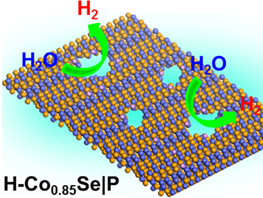For electrocatalytic and photoelectrochemical hydrogen production, it is important to develop efficient and earth-abundant electrocatalysts. Xinliang Feng, Technical University of Dresden, Germany, and colleagues have synthesized a ternary electrocatalyst of porous cobalt phosphoselenide nanosheets for highly efficient water splitting.
The team has developed a two-step strategy: First, Co0.85Se nanosheets are converted in a hydrogenation reaction into selenide-deficient Co0.85Se (H-Co0.85Se). Then, through a phosphation treatment, a P species is introduced into the H-Co0.85Se structure (H-Co0.85Se|P) by replacing some Se atoms with P atoms. The resulting ternary nanosheets have a layered structure with a lateral size of several hundred nanometers and thicknesses ranging from 16.4 to 18.7 nm.
The ternary nanosheets have enhanced electrical conductivity and large surface areas. When they are supported on electrochemically exfoliated graphene (EG) electrodes, they show excellent catalytic activity for the hydrogen evolution reaction in alkaline solutions and outperform transition metal dichalcogenides and first-row transition metal pyrite catalysts. The Se vacancies and the addition of P atoms change the electronic structure of cobalt selenide, and cause a rapid charge transfer and an optimal energy barrier for hydrogen desorption.
According to the researchers, the ternary porous cobalt phosphoselenide nanosheets may be promising for the rational design of highly efficient 2D ternary transition-metal compounds with tunable compositions for various electrochemical and photoelectrochemical (PEC) applications such as nitrogen fixation, CO2 reduction, and ammonia oxidation.
- Ternary Porous Cobalt Phosphoselenide Nanosheets: An Efficient Electrocatalyst for Electrocatalytic and Photoelectrochemical Water Splitting,
Yang Hou, Ming Qiu, Tao Zhang, Xiaodong Zhuang, Chang-Soo Kim, Chris Yuan, Xinliang Feng,
Adv. Mater. 2017.
https://doi.org/10.1002/adma.201701589
